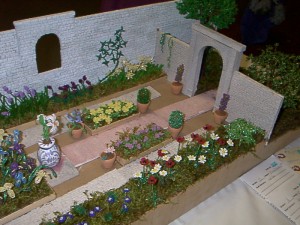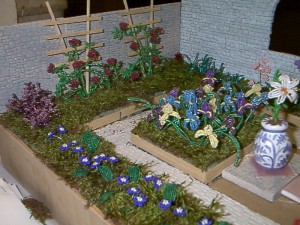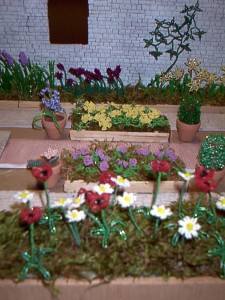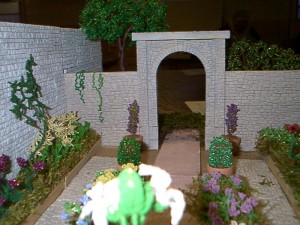Italian circa 1500
By Jonalee A. Crabb-Edwards known in the SCA as Roxelana Bramante
It all started innocently enough when I was reading The Flowers of Venice, a new book I purchased in February. I was thrilled to read on page 20:
The most ancient Venetian documents with detailed descriptions of glass-bead flowers is the Hypnerotomachia Poliphili; a book printed in 1499 by Aldus Manutius the Elder. This unusual text approaches garden design as if it were an architectural element, worthy of the house it was meant to beautify, and where vegetation was used as if it were a material such as marble or stone. The garden, which contained topiaries as well as statues, was designed according to rigid geometric patterns and could include fountains, arbors, flowerbeds, and mazes.
A scale model in silk and Murano conteria was made of this garden; unfortunately, it has not survived, and all we are left with is its description. Clearly, the book and the model demonstrate that there was a lively dialogue and an exchange of ideas at the time among the various crafts such as garden design, glass making, and weaving. It must have been magic to see a whole garden made of glass.
The uniquely Venetian art of miniature garden design became popular in European countries such as France, Germany, and England. Unfortunately, very little documentation has survived, especially because these pocket gardens were usually created behind castle walls and inside convents. We can still see some significant examples of glass bead creations at the Victoria and Albert Museum in London, though they are mostly bead-trimmed clothes and precious jewelry boxes.
First though I wanted to see this text which described the original beaded garden so I went to the library and ordered myself a copy. Then I started to think about garden designs in the same time period so I ordered every book on historical Italian gardens that the library had in its system. And in that same swirl of thought I had decided the garden was going to need walls to contain it so I went and ordered some hydrocol cast brick panels from a model train distributor. At that moment I realized that I had actually decided to make a miniature garden.
In addition I have finally (after looking for several years) found a picture of the Kunigunde reliquary crown on it you will see beaded flowers. The picture isn’t very good (the original is 2 inches square and B&W) but it does show actual beaded flowers.
The text of the Hypnerotomachia Poliphili, written by Francesco Colonna and published in Venice in 1499, contains several gardens. There is one of glass, one of silk, and another of gemstones. I have provided the entire text related to the beaded garden.
The silk garden is similarly described but throughout the book there are many descriptions of gemstone flowers to lead me to several conclusions. I have an example of a silk garden, a paradise garden, created in a convent in 1480; it follows the description in the book in that the flowers are created of silk and studded with beads and pearls. I found a picture of a small crown of the fifteenth century, which may have been buried with Saint Henry and contains beaded flowers. It would seem, from the books comparison with the works one could find in Murano, that beaded flowers were known and that these in the garden far surpassed those. It would be much easier to describe something such as a beaded garden if one already knew that beaded flowers existed. From the example of the crown we know beaded flowers did exist in some form.
I felt that at this point I had certainly made a case for making a miniature beaded garden. So the only other thing I needed to document this beaded garden was to know what gardens in general looked like in Italy around 1500. For this I read several books on medieval gardens, used period botanical books, and studied paintings.
flowers on them. The rest of the crown is made with pearls, jet, and brass spirals.
3) Italian Garden designs around 1500.
Plywood and wood scrap wood used for the foundation so the garden would be portable and contained. Support for the walls. There are four pieces of wood hammered and screwed together. Wood is period but if the garden didn’t need to be transported it would not need these supports. Wood is period, plywood is not but I emphasize this was scrap wood and not necessary to the project.
Styrofoam for the base and flower beds. Styrofoam is not period but the period method of using clay would be cost prohibitive and far too heavy to make the garden portable. Clay is period.
Clay pots and clay in the pots to plant the flowers. I know clay was used to make vessels of all proposes but as to the design of these particular clay pots, they were the only pots in this size available to me. Clay pots haven’t really changed much through the years. This Flemish painting from1525 shows plants in similar pots.
Moss to line the planting beds. Moss is period. Today it can be collected or purchased in bags. Because it was winter I didn’t collect the moss from my yard as I have in the past.
Hydracol cast brick walls and walkways – Purchased from a train modeling supply place on-line. Hydracol is fancy plaster. Other options were dollhouse walls, which were cheap plastic, or wood neither of which I thought would look right. Since this type of garden was always enclosed I went with the most period option available. I do not have the skills to make my own walls.
Paints for the walls and walkways. The red brick is done with brazilwood ink wash (ink and water) which is period. The back wall is a mix of lampblack and titanium white with gum ammoniac as the binder. I also used Sepia, Sienna, and Ochre pigments and gum arabic. The back wall alone took three days (28 hours) to paint. Because it took so long I used a three-color wash on the rest of the walls and walkways. The back wall is meant to represent the building and the other two walls are garden walls. The front has no wall so the garden can be viewed easily (the wall is implied).
Wire – in gauges 12 to 34 and colored gold, brass, and silver. The wire is as period as is available today in period sizes. Wire in period was available in tin, copper, iron, brass, gold, silver, and zinc.
Beads size 11 to 20 in the most period colors available. Beads smaller than size 15 have not been made in years. See the separate page on beads.
Sand paper for the additional walkways because sand or gravel would be too messy to transport. After the garden finds its permanent home I will put model train gravel in it to raise the level of the sandy areas.
Silk wrap I used cotton embroidery floss, which is what I had on hand. I didn’t think it differs enough from silk to justify the added cost since the wrap don’t figure into the project to greatly.
Trellises and bed surrounds little wood art sticks glued together. Period glues like sap, egg glare, and malt are messy so I used wood glue, which dries clear and quickly.
Central pot a reproduction of a sixteenth century Italian design, which I picked up at Pennsic last year. Who knew? It works for me and has that fortuitous quality about it.
Scissors to cut small wires, moss, and everything else.
Pliers with wire clipper for larger gauged wire I couldn’t cut with the scissors. Also used to pull tight beads over the wire and break bad beads.
Needle and thread for woven flowers though I only did one of these.
Paint brushes for the walls.
Saw for the wood frame.
Tweezers to plant really small flowers and reach places my hand couldn’t.
Glue to secure the walls.
File to sand the rough edges off the walls.
3. Jonquil. Also called Daffodil. I am most proud of this flower. The cups are woven on wire. The stems are wrapped and the little cellophane looking pod thing on daffodil stems has been replicated. The leaves are just twisted loops.
4. Ivy on the wall.
5. Heather.
6. Lavender.
7. Gillyflower. Also called Carnations, a larger variety of Pinks.
8. Anemone. I only made one because the center is woven on thread and I just didn’t think it looked like an Anemone. The contrast between the two shades of red wasn’t great enough and the flower took way to long to make.
9. Rose bushes on trellises. I love these. The colors work so well together. The red is gold-dust red (made with real gold) and these beads are antiques. The outer petals of the roses are all woven while the inner parts are looped. The leaves are all woven.
10. Bushes. As with the trees I didn’t assign a specific type to this bush. Many different varies are this color, many more so in the spring or fall. When I was growing up there was a bush-thing in the corner of our yard – it looked like wild celery but was a deep mauve color. I never found out what it was but, to me, it needs to be there!
11. Primulas. The leaves on these are French-beaded.
12. Daisies.
13. Poppies.
14. Fern bush.
15. Flowering bushes again, many varies flower in the spring.
16. Topiaries. Looped on wire and molded into clay.
17. Buttercups.
18. Clover. These are the smallest beads. I inserted a four-leaf clover can you find it?
19. Bellflower.
20. Musk roses.
21. Madonna Lilies. A central fountain would have been out of the question.
22. Irises.
Glass seed beads had been produced at various times throughout Europe. In Nuremberg, Germany beads were produced from 1000ce to 1340ce. Why they stopped is unknown. Venice started producing beads during Roman times stopped for awhile (reason not specified) and were fully producing again (according to documents) before 1200ce. The glass industry itself is fairly well documented in Venice and Murano (the island off the coast of Venice) continuously after 1200ce. France produced beads though the quantity produced is unclear. There is no doubt that glass seed beads are period. What is not so clear is what all the beads were used for since few beaded items exist today.
Color was another thing to consider. Beads do not come in the exact same colors as plants and the beads available today resemble period beads but the colors are all different. In Venice there is a wall the size of a set of double doors which is full of small samples of all known discontinued colors. Glass recipes have always been well-guarded secrets so if a master glass worker died before the secret was passed along then the color was discontinued the recipe lost. There were an abundance of colors available in 1500, as there are an abundance today. As an example, the roses are made using gold-dust red a color that is no longer made because it contains gold and the cost is prohibitive. This color has not been made for years (these beads are over 100 years old) though the recipe has not been lost. Transparent red is one of the hardest colors to make and there are three ways to make it: Selenium, gold, or copper. Gold was used by the Romans for beads, and there are copper red beads in China which date to 1003ce. I have no proof that transparent red was used in making beads in Europe in 1500 but it is possible that it was. This was the only real color concession I made. Theophilus, who wrote out glass color recipes in the 1120s, lists white, black, green, yellow, blue, red, and purple opaque colors but doesn’t mention beads. Looking at period stained-glass windows will give you some clues as to the vast numbers of transparent glass colors available. Early beads were probably wound but at some point the Venetians learned to make drawn beads a method that greatly increased the number beads produced and allowed beads to be made much smaller. The glass is pulled into long canes and then the canes are sorted and cut into bead size pieces. Beads then could be tumbled with sand to smooth the rough edges, (which makes them donut shaped and useful for embroidery projects) or left as is. The rough edges on non-tumbled beads would make them suitable only for projects on wire because the edges would saw threw threads.
As for the size of the beads I used the smallest beads I could find. They range from size 11 which are an average size and used for the trees, to size 20 for the clover which is so small that each bead is about the size of a grain of sand. Beads smaller than size 15 are no longer produced so all of the smaller beads I used are antiques, most over a hundred years old. Beads in size 14 and 15 come in a very limited range of colors. I feel the beads I used were as close to period as possible. Period beads also came in these very small sizes. Most smaller beads can not even be strung over a needle and were therefore useless for general embroidery projects. I feel certain this was a factor in making bead flowers in the first place what else can you do with a large quantity of beads when they don’t fit over a needle?
And then, after the regional A&S my book arrived. I was pretty disappointed because the garden wasn’t very well described but elated because, without a clear description, I didn’t make my garden wrong and it was a point in my favor that I didn’t decide to wait to see the book before I started my garden.
I started making the flowers on March tenth after having spent several days purchasing small size beads, including every shade of green I could find. Up until then I had completed one tree, the back wall and my scale work. I had done nothing except make garden plants for a full three weeks. The garden took over 500 hours which to me explains why there aren’t any around. Examples of the time involved:
A daffodil just the flower, no leaves = ½ hour * 11 daffodils = 5 ½ hours
A rose with two leaves = 1 ½ hours * 16 roses = 24 hours
An iris = approx. 45 minutes each
A daisy or a poppy = just under a ½ hour each
The trees = 40 and 45 hours
Laying out and painting the back wall = 3 days
The ivy on the back wall = 8 hours
These times don’t include how long it took to design the plants. Since I have never seen gardens this small I had to create every pattern for every plant. I had to create new stitches so leaves would look like leaves (the ivy for example) because none of the books currently on the market had what I needed though I’m sure I didn’t invent anything new because there are only so many ways you can put beads on wire.
The only pattern I did use was for the roses. While the centers are
looped, most of the roses have two outer petals using the Hobby Models pattern on the right. You will notice that wires weave back and forth through a number of beads and it is this same basic weaving that allowed the ivy to have pointed leaves and the ferns to look like ferns. The same can be said for grass spikes in that the wire goes back down through all except the top bead. All this weaving means the beads have to be counted or measured. It is a very time consuming process.
There are three methods for making beaded flowers: the Continental, the French, and the English.
The Continental is most certainly the oldest of the three. It involves looping beads on wire, weaving on wire, as in the above diagram, and other simple techniques like spikes and the ladder stitch. Most of my plants were done in this method. The French method is unique in that a wire never has to go through the same bead twice. Through a series of twists, any regular petal or leaf shape can be replicated. The French method is very useful if the bead hole is to small to accommodate more than one wire and was most likely used in period (its hard to tell which method was used in the only picture I have). The English method, almost certainly out of period, shows the English preference for needlework and English flowers are frequently woven on thread (the Anemone), sometimes with a metal frame to support the petal or leaf.
I only have one (very bad) picture of a pocket garden, under the lid of a casket, which was created in the mid-1600s in England. I have no other knowledge of what these pocket gardens looked like but they occasionally show up in inventories. I offer this one bad picture because it is very possible the idea for these pocket gardens came to England with the knowledge of making beads. Certainly it takes a great number of beads to make one of these gardens and the only place that had great numbers of beads prior to 1600 was Venice. Once England started to produce beads, they too had a great number of beads, and gardens start to appear.
I wish I had seen the book the original idea came from right away, but in the mean time I researched gardens. The majority of what was written pertained to the giant maze gardens that comprised the front lawn of the larger estates. The gardens I wanted were the side gardens, the small plots on the side of the house, which were common to monasteries, convents, and large estates. These were small walled-in flower gardens and there is little written about them. What I based the basic design on is the generic description of Medieval gardens in the book Plants from the Past. The description was easy to understand, conscience, and didn’t contradict anything else I had read. The planting of the flowers was entirely my thing since theses plants don’t need sun and aren’t subject to the weather I wasn’t worried about what it would look like through the seasons and these plants wouldn’t all be in bloom at the same time anyway.
Period gardens seem to have had many different plants mixed in the same bed but when I tried that it was difficult to tell what the plants were. My thoughts on mixed planting beds is that they look wonderful with real plants, look pretty good with beaded plants, and look terrible with miniature beaded plants this small. The garden doesn’t look very full either but I ran out of time and I don’t think it will ever look full regardless the number of flowers I put in it. I went through vast quantities of beads too, far more than I had anticipated. I went through so much green I almost ran out, and towards the end, I had to consider my available color selection when choosing plants to make.
Pleasure gardens were always enclosed (the front wall of my garden is implied so the garden can be viewed) and stone or brick walls were the most popular. Raised planting beds were popular as they helped with drainage and offered turfed seating. Flowery meads were popular. Many climbing plants were trellised so much so often an entire wall was comprised of latticework. Walkways were of grass, gravel, or brick. Plants in pots were frequently seen in the garden. And most gardens had a central fountain, statue or tree. A fountain would have been impossible to transport and difficult to come by in such a small format so I used a very nice, decorative pot of lilies central since they were a must have plant in every garden.
Another feature of this garden is framing. Framing is the ability to look through an entranceway or portal and see a perfect picture. Looking through the archway you will see the decorative pot centered with the irises and roses surrounding the lilies. A view through one window frames the iris bed. Framing seems to have been a feature of gardens starting around this time.
Brickell, Christopher (ed) Encyclopedia of Garden Plants MacMillan Publishing Co. New York NY 1992
Chatfield, Judith The Classic Italian Garden Rizzoli International Publications New York, NY 1991
Colonna, Francesco and Godwin, Joscelyn (translator) Hypnerotomachia Poliphili: The Strife of Love in A Dream Thames and Hudson New York, NY 1999 ISBN 0500019428 (original was first published in 1499 – 500 year anniversary edition)
Hay, Roy and Synge, Patrick M. Color Dictionary of Flowers and Plants Crown Publishing Inc. New York, NY 1969
Hobhouse, Penelope Flower Gardens Little, Brown & Company Boston, MA 1991
Hughes, Therle English Domestic Needlework Abbey Fine Arts, London (no date given)
Landsberg, Sylvia The Medieval Garden Thames and Hudson New York, NY 1996
Lazzaro, Claudia The Italian Renaissance Garden Yale University Press New Haven, CT 1990
MacDougall, Elizabeth Blair Fountains, Statues, and Flowers: Studies in Italian Gardens of the Sixteenth and Seventeenth Centuries Dunbarton Oaks Research Library Washington, DC 1994
Marchesi, Giovanna Poggi The Flowers of Venice Beadsmith/ Helby Import Co. Carteret, NJ 2002
Stemler, Dorothy Roses of Yesterday Hallmark Cards, Inc. Kansas City, MO 1967
Stuart, David and Sutherland, James Plants From the Past Viking Penguin Inc. New York, NY 1987
Talbot, Rob and Whiteman, Robin Brother Cadfaels Herb Garden Little, Brown & Co. Boston, MA 1996
Van Oz, Henk The Art of Devotion in the Late Middle Ages in Europe 1300-1500 Princeton University Press Princeton, NJ 1994
Wilkins, Eithne The Rose Garden Game: The Symbolic Background to the European Prayer-Beads Victor Gollancz Ltd., London 1969
Winston-Allen, Anne Stories of The Rose: The Making of The Rosary in The Middle Ages Pennsylvania State University Press, Pennsylvania 1997
Wolters, Natacha Les Perles Syros, Paris, France 1996




Deprecated: Function get_magic_quotes_gpc() is deprecated in /hermes/walnacweb07/walnacweb07ak/b1408/hoc.roxelana/new/wp-includes/formatting.php on line 4819
Deprecated: Function get_magic_quotes_gpc() is deprecated in /hermes/walnacweb07/walnacweb07ak/b1408/hoc.roxelana/new/wp-includes/formatting.php on line 4819
Deprecated: Function get_magic_quotes_gpc() is deprecated in /hermes/walnacweb07/walnacweb07ak/b1408/hoc.roxelana/new/wp-includes/formatting.php on line 4819